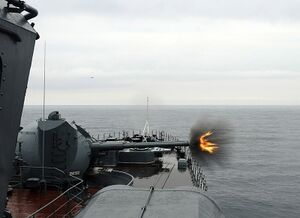Cacertian 130mm RN-SB Naval Gun
| Royal Navy Secondary Battery (RN-SB) | |
|---|---|
 The forward turret of the HMS Cora opening fire during the Refusal War. | |
| Type | Naval gun |
| Place of origin | |
| Service history | |
| In service | 1971 – present |
| Used by | |
| Wars | Refusal War FedCom Civil War Midsummer War |
| Production history | |
| Designed | 1968 |
| Manufacturer | CNRC Ordnance Bureau |
| Produced | 1971 – present |
| Variants | SBI, SBII, SBIII |
| Specifications | |
| Weight | 21.7 tons |
| Length | 9.1 meters |
| Barrel length | 7.1 meters |
| Shell | Separate-loading, case charge |
| Shell weight | 52.8 kg |
| Caliber | 130 mm |
| Action | Automatic |
| Elevation | -15° to 85° |
| Traverse | Up to 360° |
| Rate of fire | 40 rpm |
| Muzzle velocity | 760 m/s |
| Effective firing range | 24,000 meters |
| Maximum firing range | 28,700 meters |
The Royal Navy Secondary Battery is a Cacertian multi-role, automatic, rapid-firing naval gun that was developed in the very early 1970s for the Cacertian Royal Navy. Capable of engaging surface warships, aircraft, and land targets, the RN-SB and its subsequently developed variants serve as the primary gun armament for the majority of the Royal Navy’s current destroyers and cruisers. It is expected to serve well into the future.
Description
The proposal for the RN-SB began in the 1960s as the CRN began moving away from primarily gun-armed cruisers and destroyers towards new guided-missile technology. The Kaisadri-class cruisers, which were launched in 1957, were entirely missile-armed ships. Although their performance was not unsatisfactory, traditional naval commanders of the Royal Navy believed it would be pertinent to arm subsequent destroyers and cruiser with a multi-role gun should a ships’ guidance systems be knocked out in battle
Partially developed from the 150mm RN-QF naval gun, the RN-SB possesses greater accuracy and a very high rate of fire at the cost of greater weight. The fully-automated loading system in the RN-SB naval guns allow them to fire at a consistent rate of 40 rpm with testing showing it can exceed this standard to fire up to 90 rpm, although such a high rate of fire causes severe stress on the weapon system.
The fire-control system in conjunction with a dual-band radar allows the RN-SB the capability of targeting surface combatants, coastal targets for shore bombardment, as well as aircraft. It is also capable of simultaneously targeting two targets within 40 kilometers and can acquire a target as far as 75 kilometers away.
In 2017, the CNRC Ordnance Bureau began development of a guided shell.
Mounts
RN-SB guns are mounted in dual-gun turrets; there exist two different turret designs – one for destroyers and the other for cruisers. Although a single-gun turret design was considered for some destroyer classes, this design was ultimately scrapped.
Service History
The RN-SB series and its variants have been included aboard the majority of the Royal Navy’s current families of cruisers and destroyers. They were first employed in combat during the Refusal War, used against surface combatants, some aircraft, and land targets. It would also later see limited service during the FedCom Civil War